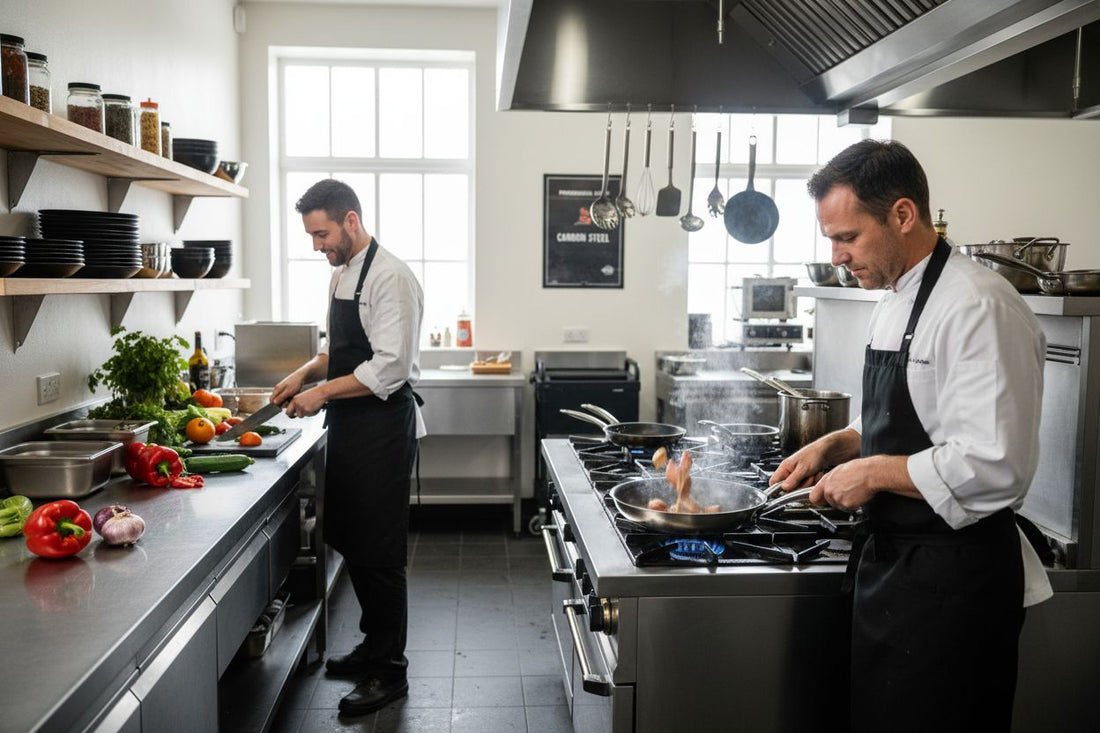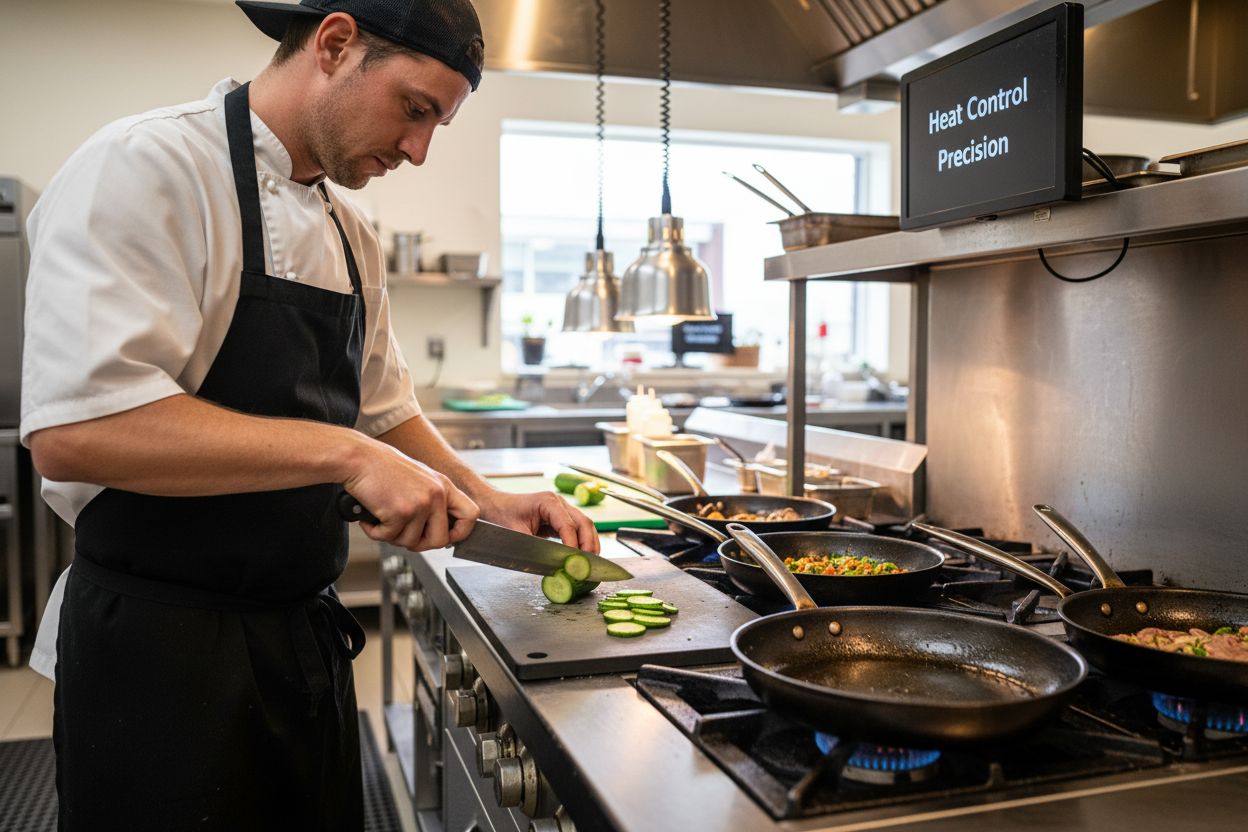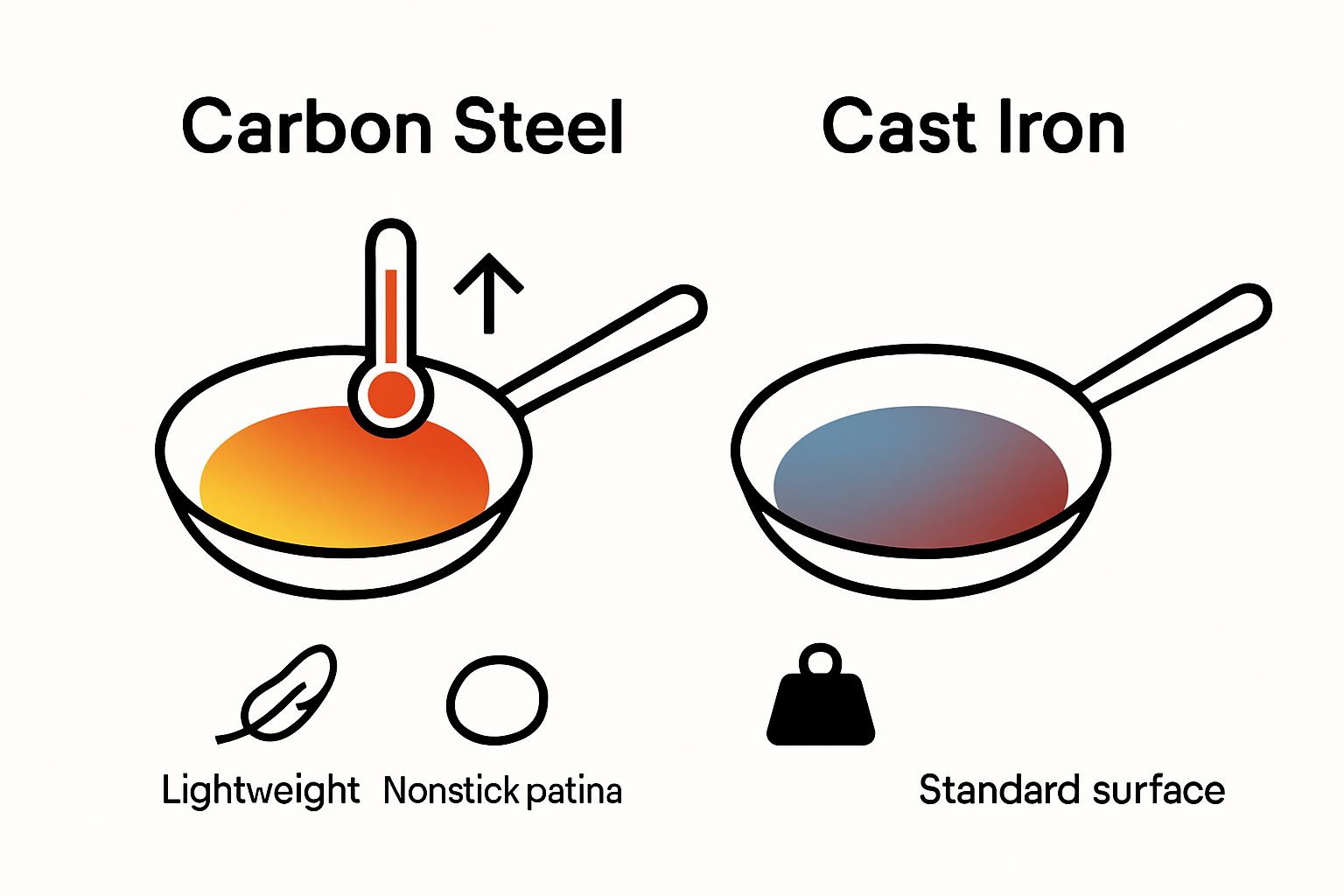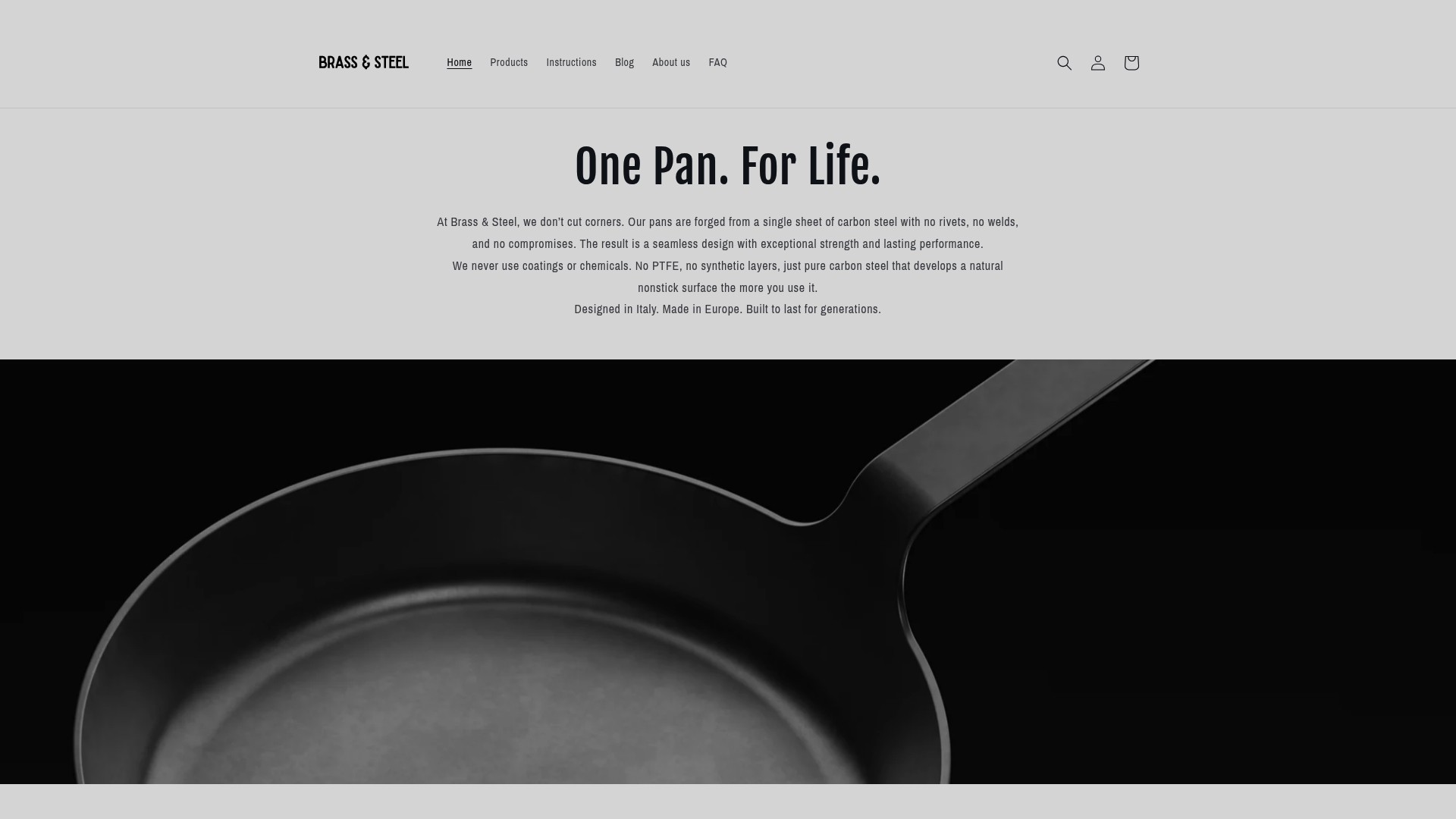
Understanding Why Professional Chefs Use Carbon Steel
Share
Carbon steel sounds like just another kitchen material until you realise that it contains up to 2.1 percent carbon by weight, setting it apart from everyday cookware. Most people expect stainless steel to rule professional kitchens, but surprisingly, carbon steel pans and knives are the secret favourites of top chefs. The real surprise is that this simple blend of iron and a small amount of carbon creates unmatched heat control and naturally nonstick surfaces chefs trust at the highest level.
Table of Contents
- What Is Carbon Steel And Its Properties?
- The Importance Of Material Choice In Culinary Arts
- How Carbon Steel Knives And Pans Enhance Cooking
- Comparing Carbon Steel To Other Cooking Materials
- Real-World Applications In Professional Kitchens
Quick Summary
| Takeaway | Explanation |
|---|---|
| Carbon steel offers exceptional heat conductivity | Rapid heat conduction allows for quick temperature adjustments, enhancing cooking precision. |
| Natural nonstick surface improves with use | Repeated seasoning creates a unique patina that enhances food release and flavour development over time. |
| Versatile for diverse cooking techniques | Ideal for high-heat tasks like searing and delicate techniques requiring precise temperature control. |
| Durable and long-lasting cookware choice | With proper maintenance, carbon steel can endure generations, reducing environmental waste compared to synthetic options. |
| Minimises chemical interaction with food | Its inert nature helps retain the original flavour of ingredients, ensuring safer and tastier culinary outcomes. |
What is Carbon Steel and Its Properties?
Carbon steel represents a fascinating metallic alloy that has transformed numerous industries, particularly professional cooking. Fundamentally, carbon steel is an iron alloy containing carbon content up to 2.1% by weight, which provides unique characteristics that make it exceptional for culinary applications.
Composition and Fundamental Structure
The magic of carbon steel lies in its simple yet powerful composition. Unlike stainless steel, which includes chromium for corrosion resistance, carbon steel consists primarily of iron and carbon. This straightforward composition delivers remarkable properties:
- High strength and durability
- Excellent heat conductivity
- Capacity for developing a natural nonstick surface
- Ability to withstand extremely high cooking temperatures
Professional chefs appreciate carbon steel precisely because of these inherent qualities. The material can rapidly conduct heat, allowing for quick temperature adjustments and precise cooking control. Its ability to develop a natural seasoned surface makes it increasingly nonstick with repeated use, unlike synthetic nonstick coatings that degrade over time.
Performance in Culinary Environments
In professional kitchens, carbon steel demonstrates extraordinary versatility. According to metallurgical research, its high carbon content makes it harder and more capable of maintaining sharp edges compared to other cookware materials. Chefs value this material for searing meats, creating perfect caramelization, and executing techniques that require rapid, even heat distribution.
Moreover, carbon steel pans develop a unique patina over time, which not only enhances nonstick properties but also contributes subtle flavour dimensions to dishes. This natural seasoning process transforms the cooking surface, making each pan essentially “personalized” through consistent use.
For those interested in diving deeper into professional kitchen technologies, read our comprehensive guide on understanding carbon steel for steakhouse kitchens.
The Importance of Material Choice in Culinary Arts
Material selection in professional cooking represents a critical decision that impacts flavour, cooking performance, and overall culinary outcomes. Professional chefs understand that cookware is far more than a simple kitchen tool it is an essential instrument that directly influences the quality and character of every dish prepared.
Chemical Interactions and Food Quality
Different materials interact uniquely with food, creating complex chemical reactions during cooking. Some metals can leach substances into food, potentially altering taste, nutritional value, and even introducing potential health risks. Chefs must consider multiple factors when selecting cookware:
- Thermal conductivity
- Reactivity with different ingredients
- Potential metal ion transfer
- Heat distribution capabilities
- Long term durability
Carbon steel stands out because it minimises these potential negative interactions. Its relatively inert composition means minimal chemical transfer, ensuring that the original flavour profile of ingredients remains uncompromised.
Performance and Precision in Professional Kitchens
Professional cooking demands precision. The right material can mean the difference between a good dish and an extraordinary culinary experience. Carbon steel offers exceptional heat responsiveness, allowing chefs to make instantaneous temperature adjustments. This rapid thermal management enables techniques like perfect searing, delicate sauce reduction, and precise temperature control.
Moreover, cookware material influences cooking technique. Some materials distribute heat unevenly, creating hot spots that can burn ingredients. Carbon steel provides consistent, uniform heating that allows chefs to execute complex cooking methods with confidence.
Explore our comprehensive guide on essential professional kitchen cookware materials to understand how material selection impacts culinary performance.
How Carbon Steel Knives and Pans Enhance Cooking
Culinary professionals consistently choose carbon steel for its exceptional performance across various cooking techniques, recognising that the material offers unique advantages that transform cooking experiences from ordinary to extraordinary.
Precision Cutting and Heat Management
Carbon steel knives represent the pinnacle of culinary precision. Their remarkable characteristics include:
- Exceptional edge retention
- Rapid sharpening capability
- Lightweight design enabling intricate cutting techniques
- Superior strength compared to traditional stainless steel
- Ability to develop a personalised patina over time
Chefs appreciate that carbon steel knives maintain an incredibly sharp edge which allows for more delicate and precise cutting. This precision is crucial when preparing ingredients that require intricate slicing, such as sashimi, fine vegetable julienne, or delicate protein portions.
Superior Thermal Conductivity and Cooking Performance
Carbon steel pans revolutionise cooking through extraordinary heat management. Unlike other materials, carbon steel conducts heat rapidly and evenly, enabling chefs to execute complex cooking techniques with unprecedented control. The material responds almost instantaneously to temperature changes, making it ideal for techniques requiring quick heat adjustments like searing, caramelising, and creating perfect fond for sauces.
Moreover, carbon steel pans develop a natural nonstick surface through seasoning, which not only prevents food from sticking but also adds subtle depth to dish flavours. This characteristic means that each cooking session incrementally improves the pan’s performance, creating a truly personalised cooking tool.
The table below breaks down the main features and advantages of carbon steel pans and knives as highlighted in the article, making it easy to see why they are valued by professional chefs.
| Feature | Description |
|---|---|
| Edge Retention (Knives) | Maintains a sharp edge far longer than many alternatives |
| Heat Conductivity (Pans) | Responds rapidly and evenly to temperature changes |
| Seasoned Nonstick Surface | Develops a natural nonstick patina that improves with continued use |
| Durability | Withstands high heat and aggressive cooking; lasts generations with proper care |
| Lightweight Design | Easier to manoeuvre compared to cast iron, suitable for intricate work |
| Precision Control | Allows for delicate cutting (knives) and precise temperature management (pans) |
| Flavour Development | Seasoning lends subtle depth to dish flavours, creating a personalised and enhanced cooking experience |

Comparing Carbon Steel to Other Cooking Materials
Professional chefs evaluate cookware materials through a complex lens of performance, durability, and culinary versatility, with carbon steel emerging as a superior choice across multiple critical parameters.
Performance Characteristics Comparison
Different cooking materials offer distinct advantages and limitations. Carbon steel distinguishes itself through unique attributes when compared to traditional cookware materials:
- Stainless Steel: Excellent durability but slower heat responsiveness
- Cast Iron: Superior heat retention but significantly heavier
- Aluminium: Rapid heat conduction but prone to warping
- Copper: Exceptional thermal conductivity but expensive and high maintenance
Carbon steel combines the best qualities from these materials.
 Its lightweight nature, rapid heat distribution, and ability to develop a natural nonstick surface make it a preferred choice for professional kitchens. Unlike other materials, carbon steel provides exceptional thermal responsiveness without compromising structural integrity.
Its lightweight nature, rapid heat distribution, and ability to develop a natural nonstick surface make it a preferred choice for professional kitchens. Unlike other materials, carbon steel provides exceptional thermal responsiveness without compromising structural integrity.
To help you understand the strengths and limitations of popular cookware materials discussed in the article, here is a concise comparison table outlining their key performance characteristics.
| Material | Heat Conductivity | Weight | Nonstick Ability | Maintenance & Longevity | Price Range |
|---|---|---|---|---|---|
| Carbon Steel | Rapid, even | Lightweight | Develops with seasoning | High, lasts generations | Moderate |
| Stainless Steel | Moderate, slower | Moderate | Minimal | Very high, virtually indestructible | Moderate |
| Cast Iron | Slow, retains well | Heavy | Develops with seasoning | Very high with care | Low to moderate |
| Aluminium | Fast, can be uneven | Very lightweight | Varies (usually coated) | Prone to warping, modest lifespan | Low |
| Copper | Exceptional, very rapid | Moderate | Minimal | Requires frequent polishing | High |
Health and Sustainability Considerations
Beyond cooking performance, modern chefs increasingly prioritise health and environmental sustainability. Carbon steel stands out as a material that minimises potential chemical interactions with food. Unlike nonstick surfaces that can degrade and release harmful compounds, carbon steel develops a natural seasoning layer that improves with usage.
The material’s longevity means reduced environmental waste. A well-maintained carbon steel pan can last generations, contrasting sharply with disposable or quickly degrading cookware alternatives. This durability translates into both economic and ecological advantages.
Discover the comprehensive comparison between iron and carbon steel for culinary applications to understand the nuanced benefits of this remarkable material.
Real-World Applications in Professional Kitchens
Professional kitchens demand cookware that performs consistently across diverse and challenging cooking scenarios, with carbon steel emerging as a versatile solution that meets the rigorous standards of top culinary environments.
High-Performance Cooking Techniques
Carbon steel enables chefs to execute complex cooking techniques with unparalleled precision. In professional settings, its unique properties shine across multiple culinary applications:
- Rapid searing of proteins at high temperatures
- Delicate sauce reduction with precise heat control
- Consistent caramelisation of ingredients
- Versatile pan-to-oven cooking methods
- Intricate multi-stage cooking processes
Professional kitchens value carbon steel for its ability to transition seamlessly between different cooking techniques. A carbon steel pan can start a steak with an intense sear, then finish it perfectly in the oven without changing cookware, saving time and maintaining consistent heat management.
Restaurant and Speciality Cuisine Applications
Different culinary specialties leverage carbon steel’s unique characteristics. French bistros rely on carbon steel for classic techniques like creating perfect omelettes and delicate fish preparations. Asian kitchens utilise these pans for wok cooking, appreciating their rapid heat distribution and ability to create complex flavour profiles through seasoning.
Moreover, carbon steel’s durability makes it ideal for high-volume commercial kitchens. Unlike more delicate materials, these pans withstand constant use, thermal shock, and aggressive cooking techniques without compromising performance.
Learn more about professional cookware recommendations for various culinary environments.
Ready to Cook Like a Professional Chef?
Have you noticed how often professional chefs turn to carbon steel for precision, flavour, and durability in the kitchen? You have just discovered why: only true carbon steel delivers rapid heat response, a naturally nonstick patina, and the resilience needed for high-performance cooking. The search for the perfect pan that marries tradition with cutting-edge design often leads to disappointment with mass-produced, coated, or riveted alternatives. These options fall short when you need reliability, health-conscious materials, and long-term value.
Discover our Carbon Steel Collection, engineered for chefs who demand more from their cookware. Each piece is forged from a single sheet of carbon steel, with no rivets or welds to weaken over time. Experience a real difference in heat control, flavour, and ease of maintenance.

Now is the time to elevate your own kitchen with tools trusted by professionals. Visit Brass & Steel and bring home pans crafted for a lifetime of service. Explore the best carbon steel pans available today and start creating dishes with unmatched confidence. For the ultimate upgrade in professional cookware, take the next step by viewing our full Carbon Steel Collection now.
Frequently Asked Questions
Why do professional chefs prefer carbon steel over stainless steel?
Professional chefs choose carbon steel for its exceptional heat conductivity and ability to develop a natural nonstick surface. This allows for rapid adjustments in cooking temperature, making it ideal for techniques that require precision, such as searing and caramelising. Experience the difference by trying a carbon steel pan in your cooking routine.
How does carbon steel enhance the flavour of dishes?
Carbon steel pans develop a unique patina that improves with use, adding depth to the flavours of the dishes cooked in them. This seasoning process also creates a natural nonstick surface, minimising any unwanted flavours from leaching into the food. Start seasoning your carbon steel cookware to enhance your cooking experiences over time.
What maintenance is required for carbon steel cookware?
To maintain carbon steel cookware, it is essential to keep it clean and seasoned regularly. Clean your pan with hot water and a gentle sponge; avoid using soap, as it can strip the seasoning. Perform this upkeep every few uses to ensure optimal performance and longevity.
Can carbon steel cookware be used in the oven?
Yes, carbon steel cookware is versatile and can be used in the oven, allowing chefs to seamlessly transition from stovetop to oven cooking. Make sure your carbon steel pan is oven safe, and follow recommended temperature guidelines to prevent warping. Utilize this feature to expand your cooking techniques, such as finishing off a seared steak in the oven.
How long does it take to develop a good seasoning on carbon steel?
Developing a good seasoning on carbon steel cookware typically takes 30–60 days of regular use. During this time, with consistent cooking and care, the pan will develop a wonderful, nonstick surface. Dedicate yourself to using the pan frequently to accelerate this process and enjoy enhanced cooking performance.
What dishes are best suited for carbon steel pans?
Carbon steel pans are excellent for a variety of dishes, including searing meats, stir-frying vegetables, and making sauces. Their ability to distribute heat evenly allows for precise cooking techniques, making them suitable for everything from delicate fish to audacious stir-fries. Experiment with different recipes to see how carbon steel can elevate your culinary skills.